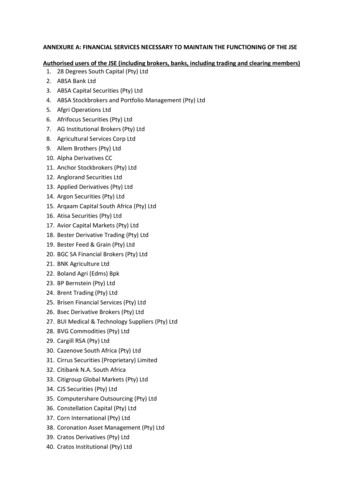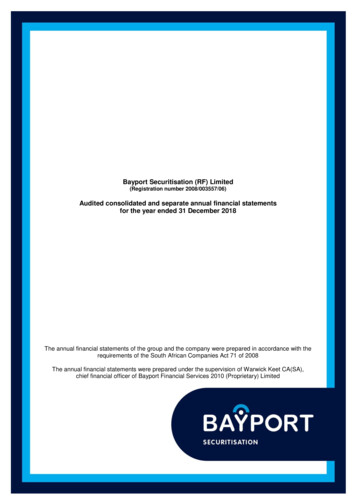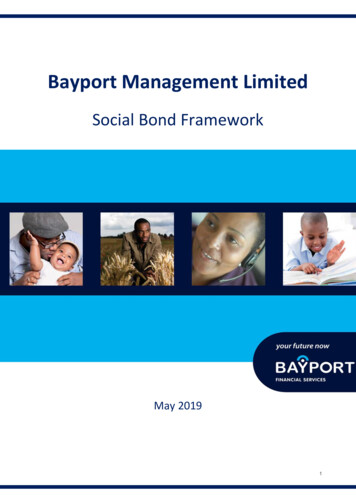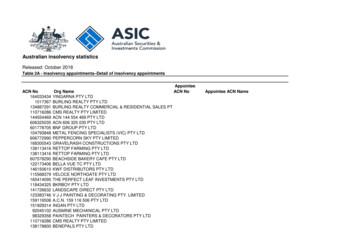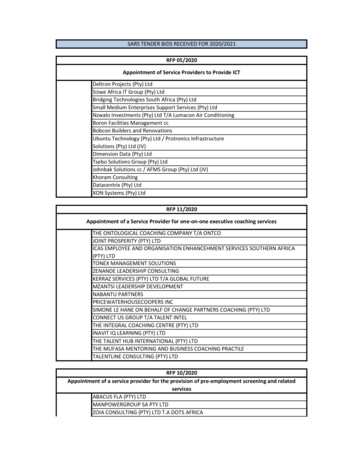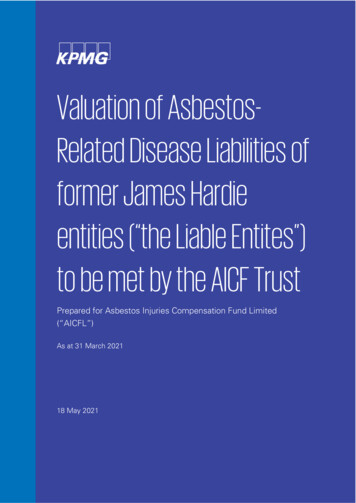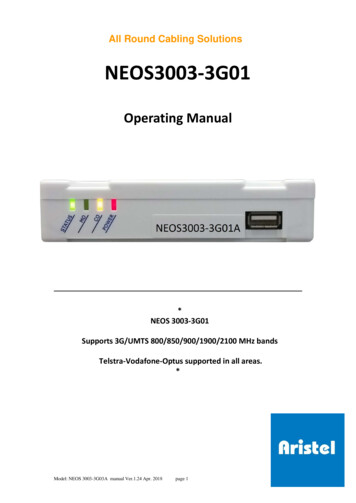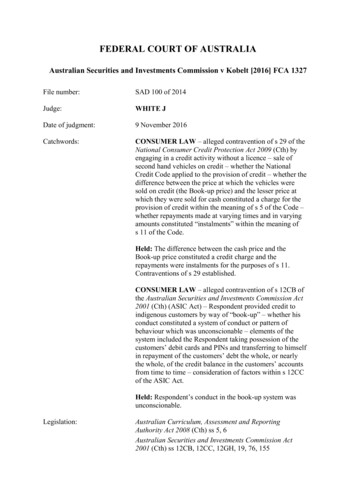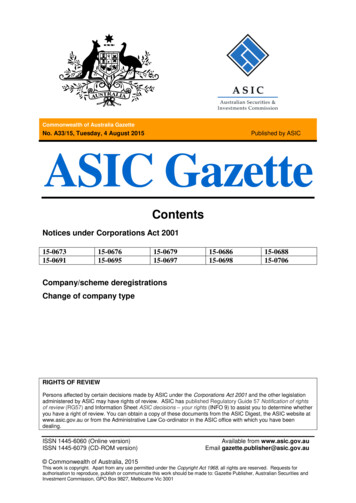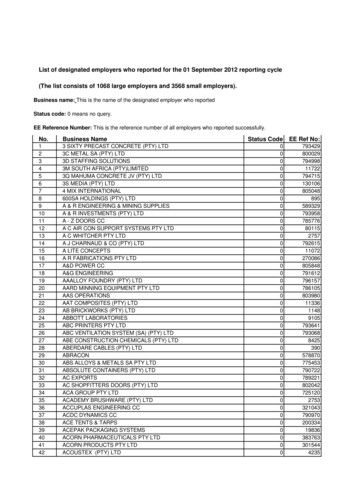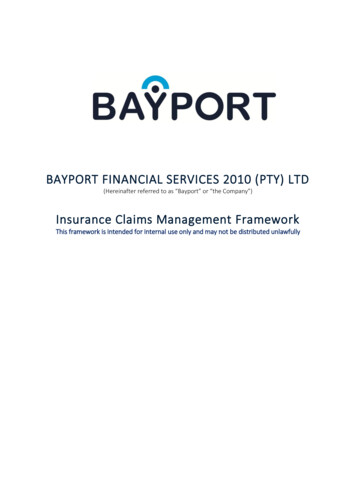
Transcription
BAYPORT FINANCIAL SERVICES 2010 (PTY) LTD(Hereinafter referred to as “Bayport” or “the Company”)Insurance Claims Management FrameworkThis framework is intended for internal use only and may not be distributed unlawfully
FOR INTERNAL USE ONLYInsurance Claims Management FrameworkPublish Date: October 2018Version 1.1TABLE OF NT CONTROL AND APPROVAL. 21.1.Document Information . 21.2.Document Change Control . 21.3.Definitions . 2INTRODUCTION . 3PURPOSE OF THIS FRAMEWORK. 4BUSINESS OBJECTIVES . 4SCOPE . 4ROLES AND RESPONSIBILITIES . 4CLAIMS MANAGEMENT KEY PRINCIPLES . 4PERFORMANCE STANDARDS AND REMUNERATION . 5THE CLAIMS PROCESS . 59.1.Claims Process Flow. 5REPUDIATIONS OR DISPUTES. 5THE ESCALATION PROCESS . 6RECORD KEEPING, MONITORING AND REPORTING . 612.1. Claims Reporting and Monitoring . 612.2. Record Keeping. 6FRAUD and ANTI-MONEY LAUNDERING . 6AMENDMENTS AND REVIEW . 6DOCUMENT REVIEW AND SIGNOFF SHEET . 7TABLE OF TABLESTable 1: Document Information . 2Table 2: Document Version Control . 2Disclaimer: The contents of this document should only be used for and by the Bayport and may not be distributed unlawfully. Olderversions are not deemed official. Only the latest version is acceptable.Page 1 of 7
FOR INTERNAL USE ONLYInsurance Claims Management FrameworkPublish Date: October 2018Version 1.11. DOCUMENT CONTROL AND APPROVAL1.1. Document InformationLast ReviewedLast UpdatedApproval StateApproved ByReviewed ByDocument CategoryAugust 2018Initial DraftOn reviewBayport Audit, Risk and Compliance Committee (ARC)Bayport Board of DirectorsBayport Enterprise Risk Committee (ERCO)ConfidentialTable 1: Document Information1.2. Document Change Control1AuthorDocumentVersionSummary of ChangesDateBukhosibethuKunene1.2First DraftSeptember 2018Table 2: Document Version Control1.3. DefinitionsBusiness Day:Any day excluding a Saturday, Sunday or Public HolidayClients:A specific person or group of persons, excluding the general public, who is or may becomethe subject to whom a financial service is rendered intentionally, or is the successor in titleof such person or the beneficiary of such service.Employee:Includes permanent employees, temporary employees, and employees, of any of thecorporate entities forming part of the group.FAIS:Financial Advisory and Intermediary Services Act 37 of 2002 and all regulations, boardnotices and codes of conduct issued in terms of the act.FSP:Financial service provider authorised in terms of the Financial Advisory and IntermediaryServices Act of 2002.Key Individual:A person registered as such in terms of FAIS to oversee and manage the business orrepresentatives of Bayport.Disclaimer: The contents of this document should only be used for and by the Bayport and may not be distributed unlawfully. Olderversions are not deemed official. Only the latest version is acceptable.Page 2 of 7
FOR INTERNAL USE ONLYInsurance Claims Management FrameworkPublish Date: October 2018Version 1.1LTIA:Long-term insurance Act 52 of 1998 and all regulations and subordinate legislation issuedin terms of the act.Person:Any natural person, partnership or trust. Includes any organ of state as defined in section239 of the Constitution of the Republic of South Africa Act 108 of 1996Representative:Any employee of a financial services provider who renders financial services to a client onbehalf of a financial services provider as defined in the FAIS ActRepudiateAny action by which an insurer rejects or refuses to pay a claim or any part of a claim, forany reason, and includes instances where a claimant lodges a claim; in respect of a loss event or risk not covered by a policy; and in respect of a loss event or risk covered by a policy, but the premium or premiumspayable in respect of that policy are not paid.Third Party:This is: a product supplier another financial services provider an associate of a product supplier or a financial services provider a distribution channel any person who, in terms of an agreement or arrangement with a person referred to inthe four bullets above, provides a financial interest to a provider or its representatives.2. INTRODUCTIONBayport as an authorised financial services provider has a responsibility to conduct itself honestly,with integrity, fairness, dignity and ethically wherever it operates, with due regard to theenvironment, the societies in which it operates and its other stakeholders. This framework hasthus been developed to provide structure, guidance and direction on the management ofinsurance claims within Bayport. Supported by specific procedures which are documentedseparately to provide clearly defined steps, activities and decisions at different functional levels,this framework is the overarching guide which provides a broad overview of how Bayportapproaches claims management. The framework incorporates specific practices, tools, methods,principles and standards in line with the requirements of Section 42 of the LTIA, referred to as thePolicyholder Protection Rules (as amended). As contemplated in Chapter 2 of the aforementioned,this framework seeks to ensure fair treatment of policyholders and beneficiaries and will bereviewed regularly.Disclaimer: The contents of this document should only be used for and by the Bayport and may not be distributed unlawfully. Olderversions are not deemed official. Only the latest version is acceptable.Page 3 of 7
FOR INTERNAL USE ONLYInsurance Claims Management FrameworkPublish Date: October 2018Version 1.13. PURPOSE OF THIS FRAMEWORKWhilst this framework sets the high-level standards for Bayport, Bayport has formulated andimplemented detailed measures to proactively ensure compliance with these standards, havingdue regard for the specific business environment within which Bayport operates.This framework is related to and must be read with the Bayport Claims Handling Process and theTRAFICC Claims Assessment Process. The purpose of this Claims Management Framework isprimarily to provide the framework of how insurance claims are processed and assessed in therendering of financial services to Clients.4. BUSINESS OBJECTIVESThe primary objectives of this framework are to: give guidance on how to handle insurance claims according to Bayport’s values ensure fairness in the interests of clients, employees and Bayport document the process for processing and assessing insurance claims lodged by Bayport clients5. SCOPEThe requirements outlined in this framework apply to the insurance function of Bayport, includingall affiliated intermediaries. This framework regulates processes and procedures according toexisting legal obligations contained in the LTIA, FAIS and any other applicable legislative provisionand should therefore not be construed or applied in a way that contradicts such duties andobligations, nor is it designed to replace such duties and obligations.6. ROLES AND RESPONSIBILITIESKey IndividualsIn terms of FAIS, the key individuals are responsible for managing or overseeing the activities ofBayport as they offer financial services. In terms of this framework, the key individuals must ensurethat adequate resources are allocated to claims handling and that any person dealing with claimsis: adequately trained; experienced in claims handling and appropriately qualified;The key individuals are also responsible for providing relevant input and guidance to theoperational areas or support functions.Insurance SupervisorThe Insurance Supervisor is responsible within Bayport, to ensure that all claims lodged are treatedin line with this framework and that any person dealing with claims is; not be subject to a conflict of interest and; is adequately empowered to make impartial decisions or recommendations.7. CLAIMS MANAGEMENT KEY PRINCIPLESThis Claims Management Framework must be maintained, operated adequately and effectivelyand ensure that:a. It is proportionate to the nature, scale and complexity of Bayport’s business and risks;Disclaimer: The contents of this document should only be used for and by the Bayport and may not be distributed unlawfully. Olderversions are not deemed official. Only the latest version is acceptable.Page 4 of 7
FOR INTERNAL USE ONLYInsurance Claims Management FrameworkPublish Date: October 2018Version 1.1b. It is appropriate for the business model, policies, services and policyholders and beneficiariesof the Bayport;c. It enables claims to be assessed after taking reasonable steps to gather and investigate allrelevant and appropriate information and circumstances, with due regard to the fair treatmentof claimants;d. It does not impose unreasonable barriers to claimants.8. PERFORMANCE STANDARDS AND REMUNERATIONBayport will not compromise its principles for short-term advantage. As such and as part of thevalues of Bayport, the adherence to high standards of personal integrity and ethical performanceof the officers, directors, employees or subsidiaries of Bayport is expected. Therefore, to ensureobjectivity and impartiality, the monitoring and enforcement of non-conformance of the saidstandards and performance shall be done in line with the Bayport’s Conflict of InterestManagement Policy.9. THE CLAIMS PROCESS9.1. Claims Process FlowClaimOriginationClaim LodgingClaim ClaimFinalisationClaim OutcomeCommunicationClaimsReportingFigure 1: Claims Process FlowIntricate details and timelines of each step of the process flow are defined in the BayportClaims Handling Process and the TRAFICC Claims Assessment Process which are separatelydocumented. Such processes include but are not limited to;1. Expected timeframes for each of the stages2. Circumstances in which the aforementioned timeframes may be extended3. Circumstances in which interest will be payable in the event of a late claim together withthe process to be followed in such an instance and the rate of interest payable.4. Communication with claimants on claims processes and procedures together with theappropriate communication at relevant stages of claims.10. REPUDIATIONS OR DISPUTESBayport must communicate the following information to the claimant: The reason for the decision; The facts that informed the decision; The process of disputing a repudiated claim; The right to lodge a complaint to the relevant Ombud with;o The contact details of the relevant Ombudsman and the limitations of such OmbudDisclaimer: The contents of this document should only be used for and by the Bayport and may not be distributed unlawfully. Olderversions are not deemed official. Only the latest version is acceptable.Page 5 of 7
FOR INTERNAL USE ONLYInsurance Claims Management FrameworkPublish Date: October 2018Version 1.111. THE ESCALATION PROCESSShould a claimant or customer be dissatisfied with the outcome of the claim assessment, he/shemay direct their dissatisfaction to Bayport in line with the internal dispute resolution processdetailed in Bayport’s Complaints Handling Policy. Bayport may refer the matter to the Insurer forreview of the decision.Should this result in a decision that is still unsatisfactory, the matter may be referred to Bayport’sInternal Dispute Arbitrator, before referring it to an external body, such as the Ombud for LongTerm Insurance.12. RECORD KEEPING, MONITORING AND REPORTING12.1. Claims Reporting and MonitoringTwo reports are produced by the Bayport Insurance Division for internal purposes. Thesereports are the Weekly-Paid Claims report for tracking purposes and the Credit Committeeclaims report which is a monthly report for business performance tracking purposes.Trends, risks and remedial actions to review product design and disclosures in line with theprinciples and outcomes of TCF is undertaken regularly on a quarterly basis.Furthermore, as part of the overall risk management framework of Bayport, Insuranceclaims are listed in the departmental risk register of the Insurance department where RootCauses are defined and monitored on a monthly bases together with the key controls inplace to mitigate such risk. This is done in order to test the effectiveness of such controlsand ensure that the desired outcomes of the claims management framework are met.12.2. Record KeepingAll claims received, assessed, and finalised will be kept for a minimum period of 5 years.Such claims are stored as electronic scanned copies on the internal network drives. Thesedrives are backed up and stored centrally on the organisation’s backup servers, a copy ofwhich is also backed up via cloud storage.13. FRAUD and ANTI-MONEY LAUNDERINGIn line with the Bayport FICA Risk and Compliance Management Programme, Bayport is committedto meeting its obligations in combatting fraud, anti-money laundering and the financing ofterrorism and to comply with the relevant legislation and with the Financial Intelligence CentreAct, No. 38 of 2001 as amended. Bayport thus has a compliance programme for combatting fraudand money laundering which is specific to its exposures and vulnerabilities. The said Programmeis cognisant of the claims management function.14. AMENDMENTS AND REVIEWThis framework can be changed, modified, revised or can be rescinded completely by Bayport atany time with appropriate approvals. Trends, risks and remedial actions to review product designand disclosures in line with Treating Customers Fairly principles will be taken on an annual basis.Disclaimer: The contents of this document should only be used for and by the Bayport and may not be distributed unlawfully. Olderversions are not deemed official. Only the latest version is acceptable.Page 6 of 7
FOR INTERNAL USE ONLYInsurance Claims Management FrameworkPublish Date: October 2018Version 1.115. DOCUMENT REVIEW AND SIGNOFF SHEETDocument Review1.This framework was reviewed and signed by the Executive: Legal & Compliance, on27 September 2018. The signed version is available for inspection, on request from theCompliance Manager or Company Secretary.2.This framework was reviewed and approved by the Enterprise Risk Committee on6 November 2018, and signed by the Risk Committee Secretary in confirmation of thecommittee’s approval. The signed version is available for inspection, on request from theCompliance Manager or Company Secretary.Governing Body Approval1.Audit Committee Approval:This framework has been reviewed and approved by the Company’s Audit, Risk andCompliance Committee at its meeting held on 3 December 2018, as evidenced in theminutes of that meeting, an extract of which can be obtained from the CompanySecretary.2.Board Approval:This framework has been approved by the Company’s Board of Directors at its meetingheld on 3 December 2018, as evidenced in the minutes of that meeting, an extract ofwhich can be obtained from the Company Secretary.Disclaimer: The contents of this document should only be used for and by the Bayport and may not be distributed unlawfully. Olderversions are not deemed official. Only the latest version is acceptable.Page 7 of 7
Bayport Audit, Risk and Compliance Committee (ARC) Bayport Board of Directors Reviewed By Bayport Enterprise Risk Committee (ERCO) Document Category Confidential Table 1: Document Information 1.2. Document Change Control Author Document Version Summary of Changes Date 1 Bukhosibethu Kunene 1.2 First Draft September 2018

